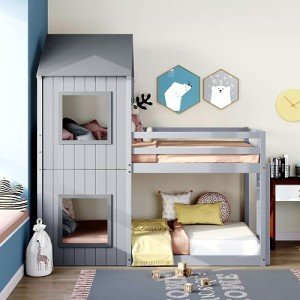Exploring Bunk Beds: A Comprehensive Guide
Bunk beds have long been a staple in children's bedrooms, dorm rooms, and even homes with restricted space. Not just do they provide a useful sleeping service, but they also develop a fun and imaginative environment for children and a great space-saver for adults and families. This post will explore everything you need to know about bunk beds, from types and materials to safety pointers and purchasing guidance.
Tabulation
- Types of Bunk Beds
- Conventional Bunk Beds
- Loft Beds
- Triple Bunk Beds
- L-Shaped Bunk Beds
- Product Options
- Wood
- Metal
- Safety Considerations
- Buying Guide
- Frequently asked questions
Types of Bunk Beds
Bunk beds are available in numerous designs to fit different needs and choices. Here's a breakdown of the most common types:
Conventional Bunk Beds
Standard bunks usually feature two beds stacked vertically on top of one another. These beds are perfect for brother or sisters sharing a room or for optimizing sleeping space in guest spaces.
Loft Beds
Loft beds stand similarly to traditional bunk beds but do not have a lower sleeping location. Instead, they often incorporate a desk or seating area below, making them a great choice for small spaces requiring multifunctionality.
Triple Bunk Beds
Triple bunk beds are created for three residents, with beds stacked in a three-tier configuration. Bunk Beds For Sale lavonabrinkmann.top are less typical however can be a fun solution for large households or sleepovers.
L-Shaped Bunk Beds
With one bed placed horizontally and the other vertically, L-shaped bunk beds are often equipped with extra features such as desks or storage drawers and can complement corner spaces in a room.
Contrast of Bunk Bed Types
| Bed Type | Perfect Use | Description |
|---|---|---|
| Standard | Shared bedrooms or visitor rooms | Two beds stacked vertically |
| Loft | Small spaces needing multi-purpose space | Upper bed with open space below |
| Triple | Large families or pajama parties | Three beds stacked vertically |
| L-Shaped | Corner or flexible spaces | A mix of vertical and horizontal beds |
Product Options
Bunk beds are manufactured from numerous products, with wood and metal being the most typical. Each product has its advantages and disadvantages.
Wood
- Resilience: Generally robust and can stand up to years of usage.
- Aesthetic Appeal: Offers a traditional look that can mix with various decorations.
- Weight Capacity: Typically sturdier; can support much heavier weights.
- Downsides: May be more expensive than metal options and can be prone to scratches.
Metal
- Toughness: Generally light-weight and simple to move but still durable.
- Modern Design: Often can be found in sleek designs, making it appealing for modern spaces.
- Economical: Usually less costly than wood alternatives.
- Disadvantages: Can be cold to the touch in winters and may not have the same aesthetic appeal for some purchasers.
Security Considerations
When it comes to bunk beds, security can not be ignored. Here are essential security pointers to remember:
- Guardrails: Ensure that the leading bunk has guardrails on both sides to prevent falls.
- Tough Construction: Check for a strong construct and strong products to stand up to weight and movement.
- Weight Limit: Adhere to the producer's weight limit for both the upper and lower bunks.
- Ladder Design: Choose bunks with a safe, easy-to-climb ladder and avoid any sharp edges or rungs.
- Age Restrictions: Most makers recommend that children under the age of 6 should not oversleep the upper bunk.
Buying Guide
When looking for bunk beds, consider the list below elements to discover the best suitable for your requirements:
- Space Availability: Measure the room size and ceiling height, ensuring there is adequate space for the top bunk.
- Bed Size: Decide between twin, full, or bigger sizes based on your needs and the size of the room.
- Design Preference: Consider the overall decor of the bedroom to find an ideal design.
- Relieve of Setup: Look for a bunk bed that is straightforward to assemble.
- Budget: Bunk beds are available in different price varieties, so figure out a budget plan before starting your search.
FAQs
1. What is the suggested age for kids to sleep on the leading bunk?
Kids aged six and older are generally advised to sleep on the top bunk to decrease the danger of falls.
2. How can I make my bunk bed more secure?
To boost security, ensure guardrails are effectively set up and examine that the bed is put on a flat surface area. Additionally, encourage children to use the ladder carefully.
3. Can I transform a bunk bed into 2 separate beds?
Lots of bunk beds are developed to be convertible. Check the manufacturer's requirements for convertibility features.
4. What devices are readily available for bunk beds?
Typical devices consist of bed linens, storage drawers, staircases rather of ladders, and tented canopies for an enjoyable visual appeal.
5. How do I keep my bunk bed?
Regular checks for loose screws or structural integrity can assist guarantee security. Dust the bed frequently and tidy spills immediately to keep the materials in good condition.
Bunk beds are versatile and a space-efficient service for different living situations, from kids's rooms to visitor lodgings. With numerous designs and products readily available, potential purchasers have a wealth of alternatives to think about, guaranteeing a mix of practicality and looks. By focusing on safety and following the suggestions outlined in this guide, people can discover the best bunk bed that matches their space and way of life, all while developing a pleasurable sleeping environment.

